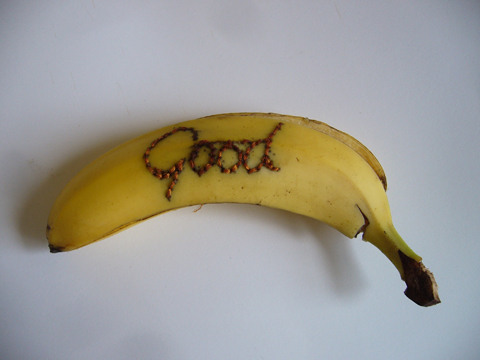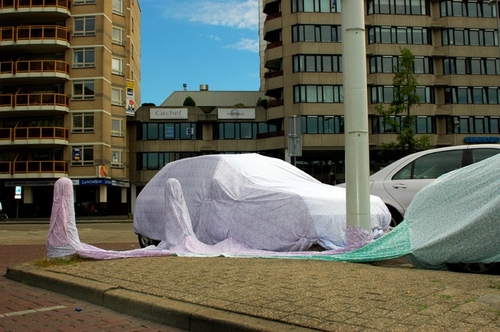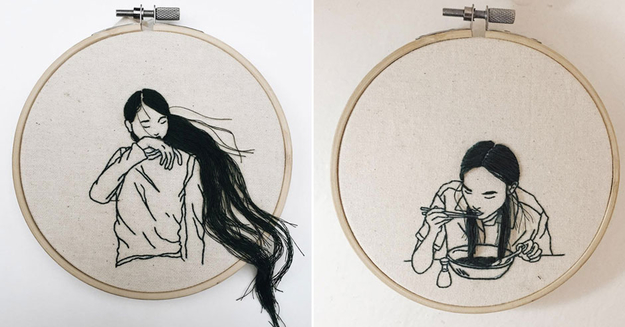Flowers stitched in clean white cloth, hand-crafted cardigans and sweaters that look a little too old-fashioned to wear, those doilies passed on from your grandma that you keep buried in drawers, rocking chairs, quietude and submissiveness; these are a few common traditional connotations embroidery carries. You normally don’t associate embroidery with radical feminism, explicit representations, or a craft that possesses the power to deconstruct narratives and cross boundaries. Despite, or perhaps exactly because of embroidery’s identity as a craft that used to symbolize female passivity, docility and domestic values, there has been a huge resurgence of the practice both in contemporary art circles but also as a pastime for many people of all ages and genders who love to get crafty. Let’s dive deeper into some of the different, and often overlooked, elements of embroidery that are prominent in the way it has been re-appropriated and transformed over the past few decades.
Art, Craft or Both?
For centuries, the canon of Western art has imposed a separation between "art" and "craft", the first being mostly associated with the masculine and the myth of the Great Artist, the Creator. Linda Nochlin studies this phenomenon on her essay “Why There Have Been No Great Women Artists?”, where she elaborates on how any form of craft has been perceived as simply decorative and of a utilitarian character. According to her, art is seen as a form of higher creation and craft is reduced to something more simple, practical and everyday, with less substance or grandeur. Craft is also connected to the feminine and the private sphere, thus, unrecognized by a male patriarchal canon as any form of "true" art. However, all sorts of craft practices, including embroidery, not only possess an aesthetic character and value, along with a set of techniques, but also serve as a living archive that documents the life experiences of women since it was one of the few creative outlets they were being offered. Moreover, nowadays, there is a plethora of contemporary artists that are choosing embroidery as their main medium, breaking down, in this way the classifications of "high" and "low" art, or art versus craft altogether and experimenting with the limits and boundaries of what embroidery can be.
Embroidery is Subversive
All too often, in the fight for feminist emancipation and empowerment (when that seeks to be achieved through art), we tend to prefer other mediums, ones that are more provocative, more out there, mediums which stray from traditionally feminine values and associations like the one embroidery has. See for example all the performance and body art from the 70's and 80's. But in our rejection of feminine practices precisely because they are too "girly", we often end up assuming that something traditionally linked to womanhood, like embroidery, cannot achieve any radical change. That is because of its past identity as something that was binding women to the private sphere, or something that was taught for the mere purpose of making a good housewife, so, not exactly the super transgressive thing that will get us to emancipation. However, by choosing less feminine forms of resistance we end up re-ascribing the same patriarchal dogmas we try to abolish. What if those associations, domesticity, docility, passivity, obedience, are what makes any craft the perfect subversive means of negating patriarchal structures? In her book The Subversive Stitch: Embroidery and the Making of the Feminine Rozika Parker writes;
"because of its history and associations embroidery evokes and inculcates femininity in the embroiderer. But it can also lead women to an awareness of the extraordinary constraints of femininity, providing at times a means of negotiating them, and at other times provoking the desire to escape".
In a sense, embroidery is a perfect example of a true subversive artistic medium when it is used in that context, since it further highlights the paradoxes of essentialist gender binary ideas.
Silver Tongue by Sally Hewett - Embroidered jersey, foam padding, embroidery hoop, 2012. 
Embroidery is Craftivism
In a similar vein, when it comes to its sociopolitical identity and presence, embroidery is a form of craftivism; The Craftivist Manifesto is a collaborative text by various artists, writers and activists that defines craftivism as the re-appropriation of traditional female hobbies to advocate for societal change. They write: "Craftivism is about creating wider conversations about uncomfortable social issues.”, "Craftivists open minds and hearts. It’s about connecting through, by and with craft and creating a more passionate community”. This combination of art and activism is not a new concept since embroidery was used as means of advocating for women's rights already from the times of the Suffrage movement.
Embroidery is Experimental
Both in terms of materials and representations, embroidery leaves great space for trying out new things. A hoop with some plain fabric is like a blank canvas, inviting for all sorts of manipulations and technical experimentation. A lot of embroidery artists are taking on a multidisciplinary approach, producing embroideries that visually borrow from photography and graphic design, which results in a visually intriguing and ambiguous products, with the works of Evelin Kasikov and Diane Meyer being an example of that. Others use experimental, and even abject, materials like trash, cigarette butts, food stains, hair and other found objects as embellishments, some notable examples being the works of Noelle Cuppens, Leslie Schomp, Kapheine and Sheena Liam. Another instance of experimental and cross-stylistic embroidery is the work of queer artist Paul Yore, whose assemblage pieces combine elements of pop art, psychedelic art, porn and excess and are loaded with recycled and found objects. He describes his work as iconoclastic appliqué and explores how meaning and the symbolic order is subverted in his patchworks. Embroidering on objects as small as a letter opener and as large as a car is another embroidery trend that transforms the everyday, creating interesting visual commentary. This is showcased in embroidery works by Ulla Stina Wikander, Hélène Barrier and Desiree Hammen, who is also the tutor of the Radical Embroidery workshop here at Mediamatic.
Mauer Park from the Berlin series by Diane Meyer - Embroidery on inkjet photographic paper, 2012
Embroidery is Sustainable
Embroidery is all about re-use. Since you can embroider on almost anything, many embroiderers choose to get fabrics from vintage and second-hand shops and markets, thus, using what is already there and transforming that very thing into an artistic product or a wearable item. Plus, including found objects is also a very common practice. An interesting example of sustainable embroidery is the work of Anaïs Beaulieu who embroiders on plastic bags, turning something that would take a notorious amount of time to decompose in a landfill into a unique piece of art.
Futiles by Anaïs Beaulieu - Plastic bag embroidered with cotton
Embroidery on banana - Untitled piece by Sarah Greaves, banana, embroidery, silk, thread, 2011. 
Embroidery is DIY, an alternative to capitalist mass production
Late capitalism is characterized by an overabundance and excess of material goods that stem from unsustainable and unethical mechanisms of industrial mass production. From fast fashion to cheap plastic home decorations, it has become extremely cheap and easy to dress and decorate, but with a huge environmental and ethical cost. And this is where embroidery comes in as an alternative. The embroiderer takes time, hours working on a single piece, which in itself is a radical act that defies the convenience of factory-produced items. To stop and take the time to not give yourself up to the fast pace of life and to build a closer relationship with your labor makes that labor all the more meaningful, personal and enjoyable. The freedom and possibilities that come with embroidery and the accessibility of its materials make it a craft that anyone can practice. And the best part is, it does not necessarily require expertise or trained skill, which creates an open DIY space for experimentation. The anti-capitalist dimension of needlework also connects to craftivism since craftivism is also related to "reclaiming the slow process of creating by hand, with thought, with purpose and with love. Because activism, whether through craft or any other means, is done by individuals, not machines."
Embroidery is Transformative
Like many other art forms, embroidery is able to totally change the essence and appearance of a thing and turn it into something different. Choosing to embroider on an item of personal significance, for example, can lead to a meditative process of re-defining and transforming that very thing, and along with it, changing attitudes about it. It can be as simple as making an old sweater that you would throw away wearable again or embroidering on an object you find in the trash, turning something undesirable into something with an aesthetic, emotional or decorative value. Thinking of the connection of art and psychoanalysis, one can say that embroidery is also a form of sublimation; turning something uncomfortable, socially contested and undesirable into something we can be more proud of, something we want to keep around.
Embroidery is Community-based
Embroidery stems from a long tradition of women's circles and for centuries it was an exclusively female pastime. Of course, this has changed and embroidery is open to all genders, age groups etc. (For a queer analysis of embroidery see "Queering the Subversive Stitch" by Joseph McBrinn). This element of getting together, though, is something that is intensely needed and important to further cultivate, both in art but also society in general. One can embroider alone, but one can also do it with others and create strong and beautiful threads, both materially and metaphorically. One can craft and learn together, share, confide, teach, and use needles to gently stitch wounds. Through embroidering together we can nurture communities of conscious and inclusive creative practice.
Are you feeling inspired? Or would you like to learn more about the wild side of this craft? In February we will host the workshop 'Radical Embroidery' with artist and fashion designer Desirée Hammen. Join to create your own experimental embroidery piece and challenge norms and taboos through stitches. Find out more here!





